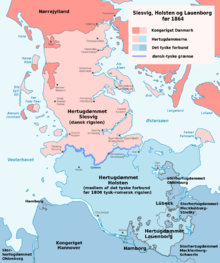Schleswig-Holstein question

The Schleswig-Holstein question concerned the national affiliation of the Duchy of Schleswig in the 19th century. Because of them, war broke out in 1848 with the Schleswig-Holstein uprising (Danish: Treårsklern ). In 1864, the German-Danish War was followed by the first German war of unification .
meaning
The dispute was not about the Duchy of Holstein , which had belonged to the German Confederation and, as a German fief, to the Holy Roman Empire since the Middle Ages , but about the Duchy of Schleswig. Schleswig was a Danish fiefdom , but divided nationally. In their argumentation, the German Schleswig-Holsteiners cited the Treaty of Ripen and the connection between Schleswig and Holstein, while the Danish National Liberals cited the connection between Schleswig and Denmark and the Eider border.
In the course of the European German Revolution of 1848/1849 , German National Liberals formed a Provisional Government (Schleswig-Holstein) in Kiel in 1848 . At the same time, a Danish bourgeois government consisting of Danish national liberals ( Eider Danes ) and conservative supporters of the entire Danish state was formed in Copenhagen . The German-minded Schleswig-Holsteiners rose up against the intention of the Danish National Liberals to constitutionally join Schleswig to the Danish Kingdom. Instead, the provisional government demanded that Schleswig be included in the German Confederation . The provisional government of the duchies finally asked the Bundestag in Frankfurt for military support. The conflict became a matter of prestige for the National Assembly . Finally, federal troops fought against the Danish troops under Prussian command until, on August 26, 1848, under pressure from England and Russia, the Malmö Armistice Treaty was signed between the war opponents Denmark and Prussia. Prussia had to reject the national idea in favor of its interests as a European power. Now, in the course of the conflict over Schleswig, there was a confrontation with the real power relations; radical and moderate members of the Paulskirche decidedly different. On September 5, 1848, the National Assembly rejected the armistice by 238 votes to 221, but ratified it on September 16. On July 2, 1850, the Peace of Berlin between the German Confederation and Denmark was finally concluded and signed eight days later.
However, an answer to the Schleswig-Holstein question has not yet been found. Only after the German-Danish War did the duchies become Prussian in 1867. The disputes ended with the referendum in Schleswig in 1920, when North Schleswig became Danish again, while South Schleswig continues to belong to Germany.
See also
literature
- Martin Rackwitz : Dahlmann's greatest challenges: The Schleswig-Holstein question and the constitutional question in the German National Assembly 1848/49 as reflected in the political caricature , in Utz Schliesky , Wilhelm Knelangen (ed.): Friedrich Christoph Dahlmann . Volume 1 of the series Democracy. Heads. Schleswig-Holstein . Husum 2012, pp. 71-100.
